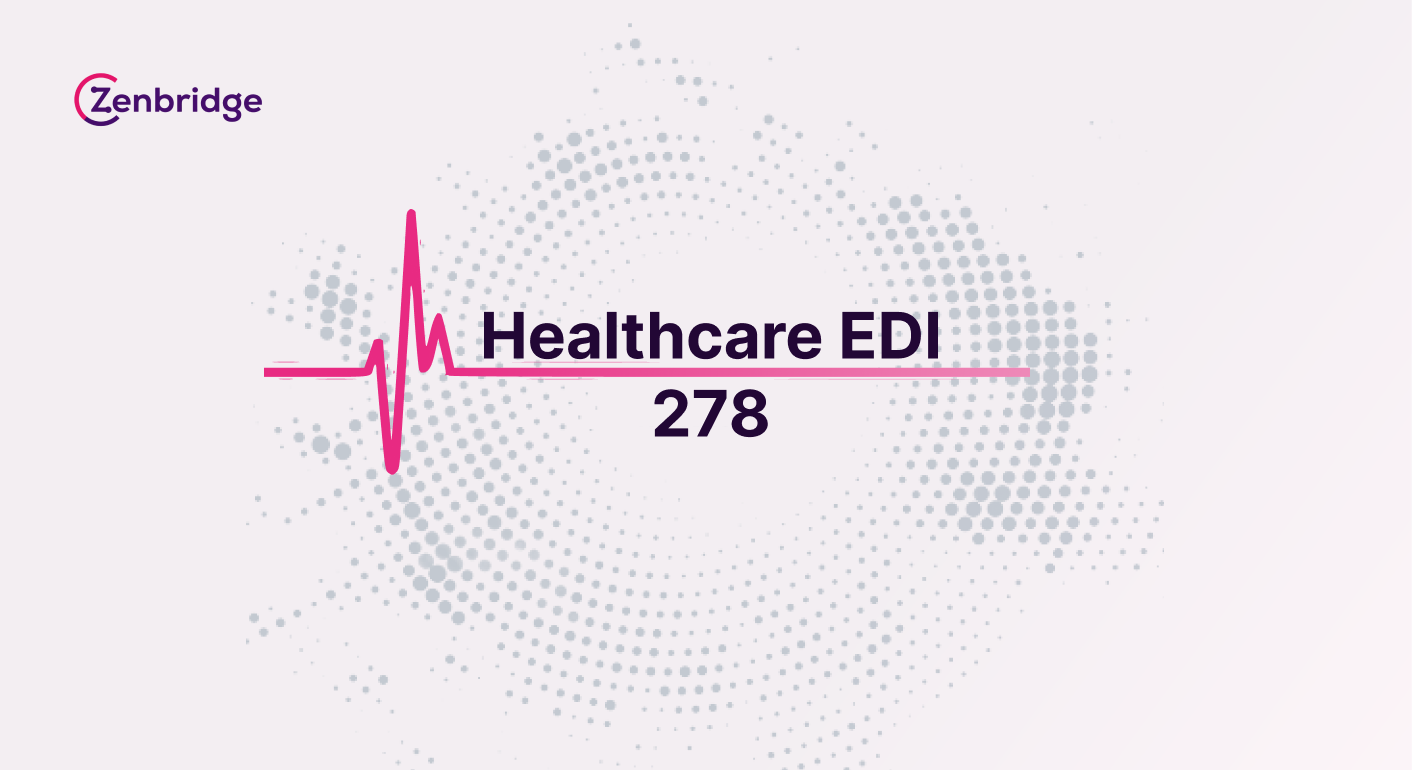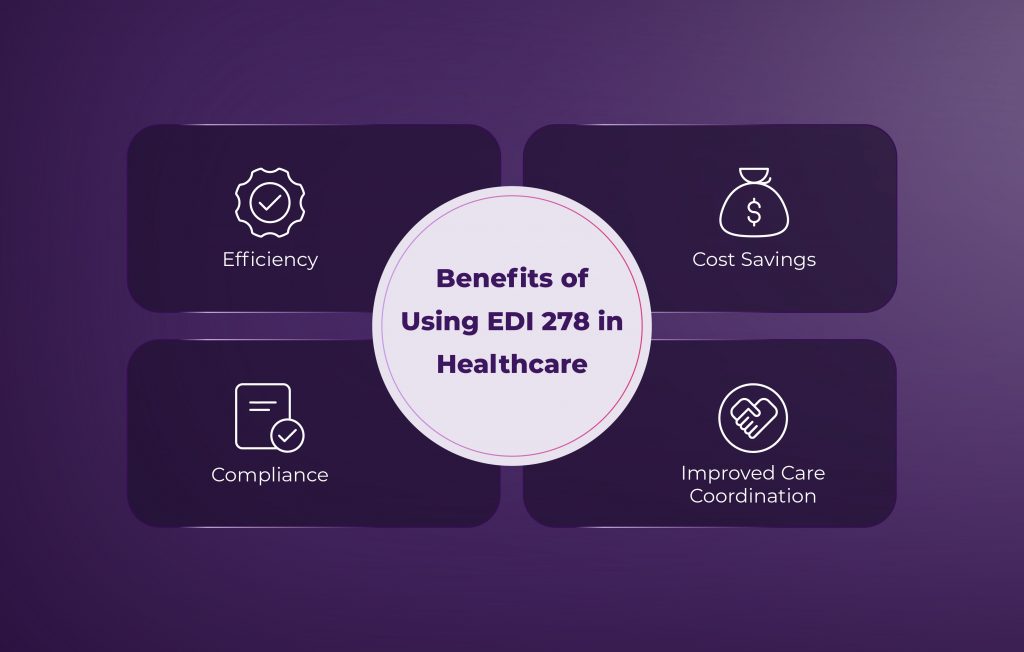EDI 278 – Simplifying Healthcare Service Authorizations

Imagine a busy hospital handling hundreds of patient records, insurance claims, and lab reports daily. Before adopting Healthcare Electronic Data Interchange (EDI), staff spent hours manually entering data, often leading to errors and delays. With EDI 278, the hospital seamlessly exchanges information with insurers and labs using standardized formats. For example, when a patient submits an insurance claim, EDI automates the process—sending accurate data instantly to the insurer and receiving approvals faster. This secure, streamlined communication ensures patients get timely care while reducing administrative burdens, showcasing how EDI 278 transforms healthcare operations into a more efficient and reliable system.
Understanding EDI 278: The Basics
The EDI 278 transaction, also known as Health Care Services Review Information, is a way for healthcare providers like hospitals to securely request authorization from insurance companies for medical services. For example, if a hospital needs approval for a patient’s surgery, it sends a 278 to the insurance company to review the details and authorize the procedure.

This transaction can serve different purposes:
- Advance notification: To inform about planned procedures or treatments.
- Completion notification: To update about patient arrivals or discharges.
- Information sharing: To send healthcare updates to other providers.
- Change notification: To report changes to previously submitted details.
The 278 can work in one direction (provider to payer) or as a back-and-forth process where the insurance company responds with approval or additional questions. Unlike other healthcare forms that may involve multiple patients, a single 278 typically focuses on one patient and one event, ensuring privacy and accuracy.
HIPAA has designated the 278 as the standard format for handling these requests and responses electronically, reinforcing security and confidentiality for sensitive patient information like diagnoses and treatments.
The Importance of Healthcare EDI
Healthcare EDI goes beyond compliance, offering significant benefits to organizations:
- Efficient Transactions: Automation speeds up data processing, reducing delays and manual effort.
- Improved Accuracy: Automated systems minimize errors, ensuring reliable and trustworthy data.
- Standardization: Universal formats simplify transactions and enhance consistency across systems.
- Cost Savings: Digital processes cut costs, saving providers billions annually compared to paper-based methods.
- Increased Productivity: EDI reduces administrative burdens, allowing staff to focus on more critical tasks.
- Enhanced Security: Advanced encryption and controlled access protect sensitive patient data.
EDI transforms healthcare operations, driving efficiency, accuracy, and security.
Key Components of EDI 278
EDI 278 transactions typically include the following key information:
- Patient Information: Name, date of birth, insurance information, etc.
- Provider Information: Name, address, and NPI (National Provider Identifier) number.
- Service Information: Description of the service, procedure codes, and dates of service.
- Diagnosis Information: Diagnosis codes and descriptions.
- Authorization Request: Specific request for pre-authorization or referral.
Workflow of EDI 278: How It Works
The EDI 278 transaction streamlines communication between healthcare providers and payers, requesting and responding to service authorizations or referrals. Below is a straightforward breakdown: an overview of the process, key parties involved, and the data flow:
Who’s Involved?
Healthcare Provider:
- This could be a hospital, clinic, or doctor requesting approval for a treatment or procedure.
Payer:
- The insurance company or health plan decides whether to approve or deny the request.
Clearinghouse (Optional):
- A middleman checks the message for errors and forwards it between the provider and the payer.
Step-by-Step Process
Healthcare Provider Creates a Request:
- The provider prepares a message asking the insurance company for approval to perform a specific medical service.
- This message includes details like the patient’s information, the type of treatment, the doctor’s information, and any supporting medical data.
Sending the Request:
- The provider sends the request directly to the insurance company or through a clearinghouse that checks for errors.
Insurance Company Reviews the Request:
The insurance company evaluates:
- Is the patient covered?
- Is the service necessary based on the diagnosis?
- Does the patient’s policy allow for this type of service?
- Some requests are processed automatically, while others are reviewed manually.
Insurance Company Sends a Response:
The insurance company responds to the provider with one of the following:
- Approval: The service is authorized, and they provide a reference number.
- Denial: The request is rejected, with reasons explained.
- Request for More Information: If details are missing, they ask for additional data.
Healthcare Provider Takes Action:
Based on the response, the provider:
- Moves forward with the service if approved.
- Revise the request or provide additional information if needed.
How the Data Flows
Creating the Request:
- The provider includes all relevant patient and service details in the request.
Validation:
- If a clearinghouse is used, it checks the request for formatting errors and ensures it meets EDI standards.
Sending the Request:
- The validated request is sent securely to the insurance company.
Generating the Response:
- The insurance company processes the request and generates an approval, denial, or request for more information.
Delivering the Response:
- The response is sent back to the provider, completing the process.
Why This Workflow is Beneficial
- Faster Approval Process: Speeds up communication between providers and insurers, avoiding delays in patient care.
- Fewer Errors: Automated data entry reduces mistakes.
- Data Security: Keeps patient information safe with encrypted and standardized communication.
- Clear Records: Maintains a complete history of requests and responses for transparency.
By simplifying how service requests and approvals are handled, EDI 278 improves efficiency and ensures timely decisions in healthcare.
Benefits of EDI 278
- Improved Efficiency: Automates the authorization process, reducing manual work and turnaround time.
- Enhanced Communication: Facilitates clear and timely communication between providers and payers.
- Reduced Errors: Minimizes errors associated with manual data entry and processing.
- Faster Claim Processing: Streamlines claims submission and reimbursement.
- Better Patient Care: Ensures timely access to necessary healthcare services.

Common Use Cases of EDI 278
- Pre-authorization Requests: For procedures, surgeries, and specialized treatments.
- Service Certifications and Reviews: Verifying the need for services, especially in long-term care.
- Notification of Admission/Discharge: Informing payers about a patient’s admission or discharge.
- Chronic Care Management Authorizations: Securing ongoing authorizations for chronic conditions.
Real-world examples of EDI 278
- Preapproval for Surgery: The hospital sends a request to your insurance company to confirm they’ll cover surgery.
- Outpatient Services: Clinics use EDI 278 to check if physical therapy or specialized treatments are covered.
- Emergency Notifications: Hospitals inform insurers of emergency admissions, ensuring claims are processed smoothly later.
- Chronic Care Approvals: For ongoing treatments like dialysis, EDI 278 ensures continuous coverage without delays.
Challenges and Best Practices
While EDI 278 offers many benefits, challenges may arise during implementation:
- Integration with Legacy Systems: Integrating EDI 278 with older systems can be complex.
- Data Quality and Consistency: Ensuring accurate and consistent data is crucial.
- Compliance with Regulations: Adhering to HIPAA and other regulations is essential.
To overcome these challenges, consider these best practices:
- Choose a Reliable EDI Provider: Partner with Zenbridge, a provider experienced in healthcare EDI solutions.
- Invest in Training: Train staff on EDI processes and data entry.
- Implement Data Quality Controls: Establish robust procedures to ensure data accuracy.
- Stay Updated on Industry Standards: Keep up with evolving EDI standards and regulations.
A Better Future with EDI 278
By adopting EDI 278, healthcare providers and payers can streamline operations, reduce costs, and enhance patient care. This transformative tool simplifies processes, ensuring faster approvals, resource optimization, and clear communication. With a comprehensive understanding of EDI 278’s components, workflow, and benefits, healthcare organizations can unlock its full potential to drive efficiency, accuracy, and collaboration in the industry.
Ready to revolutionize your service authorization process? Discover how Zenbridge’s HIPAA-compliant EDI solutions can help. Schedule a demo today and experience how our advanced platform can streamline your workflow, reduce administrative burdens, and let you focus on delivering exceptional care.